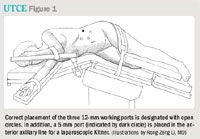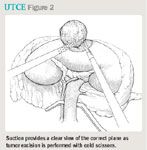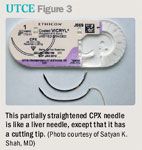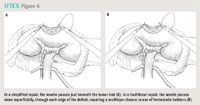Article
Simplified repair technique for laparoscopic partial nephrectomy
This revised surgical approach uses a single suturing process that improves outcomes.
Urologists describe their experience with a revised surgical approach using a single suturing process that improves efficiency, reduces warm ischemia time, and achieves excellent outcomes in kidney cancer patients.

Dr. Shah
Laparoscopic partial nephrectomy is an attractive alternative to open nephron-sparing surgery.1 However, its universal acceptance has been limited by the degree of laparoscopic skill required to excise the tumor, control bleeding, and repair collecting system entries.

Dr. Kim
In this article, we describe a simplified laparoscopic partial nephrectomy technique that achieves all of these goals efficiently and with fewer steps.

Dr. Chapman
Surgical technique
Mobilization of the kidney. The patient is placed in a full 90-degree flank position and the bed is partially flexed. A Veress needle is inserted into the ipsilateral lower quadrant to insufflate the peritoneum. A three-port transperitoneal technique is used to mobilize the kidney outside of Gerota's fascia and to dissect out the renal hilum (figure 1).

Gerota's fascia and the perinephric fat are incised to expose the tumor and renal capsule. Occasionally, a fourth port may be placed in the anterior axillary line over the kidney to provide additional retraction. Finally, a laparoscopic Satinsky clamp is inserted through a puncture site in the infraumbilical midline to clamp the renal artery. The renal vein is left open.
Partial nephrectomy. With cold scissors and suction, excise the tumor (figure 2). Visual cues help to ensure that resection is through normal renal parenchyma. We prefer cold scissors for the excision because cautery or thermal artifacts obscure identification of the correct plane. Frozen sections typically are unnecessary. As long as bleeding remains minimal, entry into the tumor is readily recognized and a deeper margin established.

Simplified repair. Several #1 Vicryl sutures on CPX needles are cut to 7 inches in length and an absorbable suture clip, such as a Lapra-Ty (Ethicon Endo-Surgery, Cincinnati), is pre-placed on each end. The CPX needles are partially straightened to allow insertion through a 12-mm trocar (figure 3). Their large size and cutting tip facilitate laparoscopic needle placement across the tumor bed.

The repair begins at one end of the defect, by passing the needle through the capsule all the way to the other side, with the needle traversing just below the surface of the resection bed. Sutures are placed in an overlapping figure-of-eight fashion. A second clip is placed on the proximal end of each stitch to maintain tension.
The key to the repair is that the needle passes immediately under the tumor bed in its course from one side of the defect to the other. By contrast, in a traditional repair, the needle only goes through the edges of the defect (figure 4).

The Satinsky clamp is then released. If there is persistent bleeding, additional figure-of-eight sutures are placed or the previously placed sutures are tightened by pulling up on the suture and placing an additional clip. Hemostatic sealant is applied over the resection bed only after complete hemostasis using sutures has been confirmed. The entire tumor bed is repaired using a single layer of sutures without the use of cautery. Collecting system entries, even when clearly noted, are not repaired separately. Passage of the needle below the entire resection bed compresses renal tissue, providing hemostasis and closing all collecting system entries.
Results
Between September 2005 and December 2008, 121 consecutive patients at Roswell Park Cancer Institute underwent the simplified repair technique as performed by Dr. Kim. The mean patient age was 61 years (range, 26 to 92 years). There were 59 left-sided, 46 right-sided, and 16 bilateral tumors. Mean tumor size was 2.6 cm (range, 0.6 to 5.6 cm). Sixty tumors (50%) were located on the posterior surface of the kidney, 57 (47%) were on the anterior surface, three (2%) were multifocal, and one was central.
Mean total operative time was 200 minutes (range, 95 to 333 minutes) and mean warm ischemia time was 21 minutes (range, 3 to 50 minutes). Mean blood loss was 250 cc (range, 10 to 2,100 cc).
Renal carcinoma was identified in 89 patients (74%). One patient (0.8%) had a focally positive margin. Mean length of hospital stay was 1.6 days (range, 1 to 7 days). Three patients (3%) with pre-existing anemia required intraoperative transfusions. Two patients (2%) experienced delayed bleeding on postoperative day 1, requiring transfusion of 2 and 4 units of packed red blood cells, respectively. During postoperative follow-up, two patients were noted to have pseudoaneurysms that were managed with selective embolization by interventional radiology. No patient developed a urine leak, and none have developed symptomatic obstruction of the collecting system as a result of the repair technique.
Discussion
Technical goals of laparoscopic partial nephrectomy include avoiding positive margins, repairing the tumor bed, achieving hemostasis, and minimizing warm ischemia. A number of techniques have been described to facilitate this procedure, including use of the argon beam coagulator, application of biological glues, intracorporeal suturing, and use of hemostatic bolsters.2-4
In our experience, routine clamping of the renal artery and cold scissor dissection allows normal renal parenchyma to be readily distinguished from renal tumor during the resection, minimizing the risk of positive margins. Routine frozen section analysis of the margins is, therefore, unnecessary.5
Our simplified renorrhaphy achieves hemostasis and closes the collecting system through a single suturing process. Key to this technique is advancement of the suture needle under the entire partial nephrectomy bed, rather than only through the edges of the defect. This results in simultaneous approximation of the parenchyma and collecting system, thereby obviating the need for multilayer closures or use of hemostatic bolsters. The large CPX needle facilitates needle placement across even a large tumor bed. This simplified repair, especially when used with absorbable suture clips, helps shorten the warm ischemia time.6
Compared with traditional laparoscopic partial nephrectomy, the simplified technique is more efficient for the surgeon, while achieving all primary goals of surgery. Our results demonstrate favorable warm ischemia times and excellent patient outcomes.
Dr. Shah is Director of Robotic and Minimally Invasive Urologic Surgery, University of New Mexico School of Medicine, Albuquerque; Dr. Chapman is a partner in Columbia Urological Associates, Columbia, SC; and Dr. Kim is an Associate Professor of Urologic Oncology, Roswell Park Cancer Institute, Buffalo, NY.
References
1. Colombo JR, Haber GP, Jelovsek JE, et al. Complications of laparoscopic surgery for urological cancer: a single institution analysis. J Urol 2007; 178:786-91.
2. Gill IS, Matin SF, Desai MM, et al. Comparative analysis of laparoscopic versus open partial nephrectomy for renal tumors in 200 patients. J Urol 2003; 170:64-8.
3. Kim FJ, Rha KH, Hernandez F, et al. Laparoscopic radical versus partial nephrectomy: assessment of complications. J Urol 2003; 170:408-11.
4. Orvieto MA, Chien GW, Tolhurst SR, et al. Simplifying laparoscopic partial nephrectomy: technical considerations for reproducible outcomes. Urology 2005; 66:976-80.
5. Nadu A, Mor Y, Laufer M, et al. Laparoscopic partial nephrectomy: single center experience with 140 patients-evolution of the surgical technique and its impact on patient outcomes. J Urol 2007; 178:435-9.
6. Orvieto MA, Lotan T, Lyon MB, et al. Assessment of the LapraTy clip for facilitating reconstructive laparoscopic surgery in a porcine model. Urology 2007; 69:582-5.
Newsletter
Stay current with the latest urology news and practice-changing insights — sign up now for the essential updates every urologist needs.















